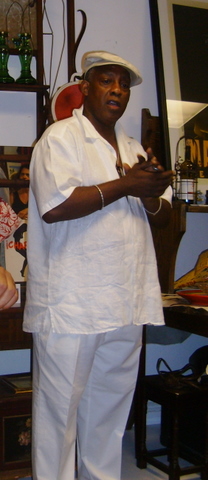Interview with Antique Dealer Albert Williams

 "These are for my wife," he said with a shy smile, "she likes the scent." And then you are immediately drawn into his delicate side, the attention to detail and a sense of merchandising perfectionism.
"These are for my wife," he said with a shy smile, "she likes the scent." And then you are immediately drawn into his delicate side, the attention to detail and a sense of merchandising perfectionism.Williams is one of a growing group of "vintage-first" souls. It seems to be their way to save the planet. A master upholsterer for nearly four decades, he stresses the need for people to consider making product changes in their lives out of items from the past, rather than living on a "mindless conveyor belt of consumerism." Williams' shop is a jumble of once-plain picture frames, now transformed into gilded mirror frames, Hollywood-looking Art Deco loveseats that need reupholstery and a treasure trove of furniture from the Victorian Period to 20th century modern design. He believes that by buying a vintage or used item, the customer is getting a better quality product than if they were to buy new.
"Furniture was made with good wood, with a sense of craftsmanship in the past," said Williams. "Now things are simply not made to last. It's no secret. It's designed that way."
He also thinks that buying antique and vintage items will help the current generation starting out on their own as adults to respect that craftsmanship and invest in its quality. He says this is particularly true of antique purchases. "They will keep their value, for the most part. When you resell a fine antique in 20 or 30 years, you will be able to recoup your investment."
Williams searches old factories, barns and other places to find items to refurbish for the vintage market. Many of his best customers are young designers in New York City who can't get enough of his "raw" materials.
"A lot of designers and decorators want to incorporate vintage items into a contemporary decor," he explained, "and this is great. Antiques, vintage items and contemporary pieces work well together. It is just a personal choice. It depends on your personality, your design sense, and how important it is to you to keep your carbon footprint small."
In his personal choices, Williams prefers to wear the vintage clothing that he sells. He likes the fit, the look and the detail. "At home," said Williams, "we live with antiques, that is just our passion, but we mix and match styles. We have early industrial furniture that fits right in with a 18th century dresser or a huge piece of art by a young unknown painter."
He stressed that living with vintage items, all the way down to his set of sterling flatware from 1910 is a choice to incorporate beautifully crafted things that come with a history. "We don't just have to keep the earth safe and clean by reducing plasic use and remembering to recycle. We have a weighter reponsibility than that. We need to keep our lives full of meaning and beauty," he said. "If we think like that, we'll stop a lot of the waste and it won't be a burden. Just by being educated about the past and acting accordingly."
This site needs an editor - click to learn more!
You Should Also Read:
Sell Your Treasures at a New York Auction
Brooklyn Flea Dishes Upscale Bargains
Related Articles
Editor's Picks Articles
Top Ten Articles
Previous Features
Site Map
Content copyright © 2023 by Karen Joyce Williams. All rights reserved.
This content was written by Karen Joyce Williams. If you wish to use this content in any manner, you need written permission. Contact
BellaOnline Administration
for details.


